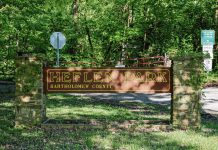Columbus’ reputation has been built on public-private partnerships.
And as the two Republicans seeking the nomination for Columbus mayor approach the May 5 primary, they are looking for future partnerships to build on that legacy.
Both Mayor Kristen Brown and challenger Jim Lienhoop have ideas to spur economic development through partnering with private entities, but Lienhoop would also like to expand the concept into education and social issues.
Brown said she is leading an effort to find private partners to develop the city’s next industrial complex.
“We are out of shovel-ready land in the community, so this is a bottleneck to the community’s growth going forward,” Brown said.
The city is interested in a former air strip near Walesboro, more than 700 acres of land on the southwestern side of the city, Brown said.
Currently rented out by the city Board of Aviation Commissioners for farming as a revenue stream for the self-sufficient Columbus Municipal Airport, the land could be developed as a future industrial site, which could attract research and development facilities or technical testing companies, Brown said.
Brown said she understands the city is asking the airport board to “put their community hat on,” agreeing to sell the property to a private developer.
“The airport board could work out a deal in theory with a developer, where they get an annuity stream instead of a lump sum, to substitute that farming income, or they could take the proceeds and buy farmland up around the existing airport,” she said.
If the aviation board wanted to continue using farmland — which generated $132,814 from the Walesboro site in 2013 — as a revenue stream, it could take the money from sale of the airport land and buy more farmland elsewhere and contract that out, she said.
Lienhoop said he also would like to see future public-private partnerships focus on economic development.
Saying nearly 85 to 90 percent of economic development activities are privately funded through the Columbus Economic Development Board, Lienhoop contends Brown has disengaged from that organization.
Established as a nonprofit in 1976, the board focuses on attracting well-paying businesses to Columbus and helping existing businesses grow and expand.
Lienhoop pledged to reinvigorate the city’s relationship with the Economic Development Board with a focus of bringing more investment and jobs to the community.
Last fall, Lienhoop represented Columbus on the board’s trade mission to China and Japan to get the city’s name on a list for Asian companies that might be interested in American investment. The costs, about $11,000 for Lienhoop to attend, were covered in the city council’s budget.
Brown went on the Asia trip in 2012 but did not go or send a city representative in 2013. In an interview last fall, Brown said the cost of the trip was exorbitant, and there were more effective uses of her time and taxpayer money than making the two-week commitment.
Brown said Columbus has had tremendous success in attracting investment and expanding existing small and large businesses in the past three years, resulting in more than 150 new jobs. Brown said she frequently promotes Columbus outside the city, but existing local businesses’ prosperity remains her first priority.
railroad Partnerships
Solving the city’s current and future transportation needs also should involve private partners, Lienhoop said.
That would include plans by the Louisville & Indiana Railroad and CSX Transportation to install high-speed a rail through Columbus, he said.
The railroads learned April 10 that they have received approval to upgrade L&I’s mainline track between Louisville and Indianapolis to increase train traffic by 13 to 15 trains per day. Those trains will be heavier and move faster, blocking the State Road 46 intersection on the west side multiple times over the course of a day when the improvements are made in about seven years. An overpass, estimated to cost as much as $35 million, has been mentioned as one solution to get around the train.
“My sense is that the railroad issue will require partnerships in all directions,” Lienhoop said. “It’s a big issue, and I’m sure some of the corporate interests are as interested in solving that problem as much as the city leadership,” he said.
In an interview after the announcement, Brown said federal officials vastly underestimated the plan’s impact on the intersection of State Roads 46 and 11 in Columbus, where train traffic delays cause daily problems for motorists.
“The crossing at 46 will be the most impacted crossing between Louisville and Indianapolis,” Brown said.
The project as approved would greatly exceed the federal threshold for supporting an overpass, a step that has been discussed locally as a way to overcome the delays caused an increase of trains coming through the city, Brown said.
However, coming up with an estimated $35 million price tag for a Columbus overpass will be a challenge because U.S. Rep. Luke Messer and U.S. Sen. Dan Coats, both Republicans from Indiana, told Brown that federal funding for an overpass would be unlikely, she said.
In a letter sent earlier to federal officials about the train proposal, Brown said that given the predicted impact, city officials feel the two railroads and federal agencies that govern road and railroad decisions should be required to cover the price tag for an overpass.
social issues Partnerships
Beyond economic development, Lienhoop also would like to see more partnerships working with schools through the United Way to address social problems affecting youth.
“When you look at Columbus, it’s pretty easy to see the economic success that we have had. But you need to remember the folks at the school system tell us that 50 percent of the kids here are on free and reduced lunch, and among first-graders it’s 60 percent,” Lienhoop said.
Bartholomew County ranks eighth the state in teen pregnancy, he said.
“I am thinking more along the lines of United Way, and the private support it receives and the support from industry,” Lienhoop said. “There are corporate players here who are very interested in the educational achievement of the workforce. Particularly with the purview of the school system, I think the mayor has the opportunity to gather people together to focus attention on critical issues.”
Brown cited her work to improve neighborhood parks in lower-income areas of the community, places she described as some of the city’s most distressed areas.
Race2Play, the city’s 2013 public-private partnership to rehab playgrounds, involved investing about $500,000 in improvements at the four parks, most of it through private donations and contributions.
The first major sponsors were the Tony Stewart Foundation and the Carter Oosterhouse Foundation. Their involvement drew other celebrity and community interest, including Subway spokesman Jared Fogle’s foundation.
The Race2Play initiative involves promoting healthy lifestyles, obesity prevention and safe neighborhoods.
A Tony Stewart-themed playground was built at Mead Village Park. New playground equipment and a shelter house was added at Pence Park. A new playground was added at Morningside, and new tables, benches and a playground was installed at the Ninth Street Playground.
“The condition of those parks was embarrassing when I came in (to office). They were unsafe,” Brown said.
The public-private partnerships allowed the city to make significant investments to clean them up and make the areas safer, she said.
Building on past success
Both candidates pointed to partnerships within the past four years as examples of how the city can continue to improve through agreements with private companies and organizations.
Brown pointed to successful partnerships in affordable housing, senior housing and the Hamilton Ice Center as examples of her administration working with the private sector to improve Columbus.
Lienhoop said the curbside recycling program, funded primarily by Cummins Inc. and 15 other area companies, and the Hamilton Ice Center renovation are examples of the city working best with private partners.
The city has invested slightly more than $200,000 in the 2015 city budget for the curbside recycling program, with nearly $1 million invested by Cummins and the other companies.
“Cummins’ contribution is what made the program go,” Lienhoop said. “What they’re doing is listening to their employees who are telling them this is what they’d like to see in the community. And so they became motivated to help.”
Both candidates said the Hamilton Center project, completed in 2014, shows what the city can do when the private sector steps up with financial support.
“It’s an architectural gem and it had gone into a total state of disrepair,” Brown said.
Hamilton Center had been left underfunded from a maintenance perspective for a number of years, she said.
“So I stepped in and proposed making a huge public investment, which the city council was on board (with) and approved,” she said.
The city agreed to invest $1.9 million to replace the facility’s roof and refrigeration equipment, while another $1.4 million in private donations finished the project, she said.
Having the private group approach the city about using some money from the failed sports complex bond to upgrade Hamilton Center started the process, Lienhoop said.
The council agreed to consider it as long as private fundraising was involved, he said.
“We weren’t going to tell them how much,” he said. “It needed to be significant and come close to matching what the city would spend. That was the genesis of the fundraising that the parks foundation did for the improvements. The notion was the city should maintain the building — the walls, the roof, the restrooms and such — and if groups want to use it for hockey or some other special purpose, that should be privately funded.”
The city, park foundation and private-sector contributors partnered to rehabilitate the structure, which opened in 1958 and was last renovated in 1974.
The Columbus Parks & Recreation Department is planning a public open house from 11:30 a.m. to 1 p.m. Thursday for a ribbon cutting and tours of the revamped facility.
[sc:pullout-title pullout-title=”Public-private partnerships” ][sc:pullout-text-begin]
Here are some examples of recent public-private partnerships for Columbus projects:
Race2Play: About $500,000 was invested to rehabilitate four city playgrounds in 2013, with most of the money raised through private donations and contributions.
Hamilton Center Ice Arena: The city agreed to invest $1.9 million to replace the facility’s roof and refrigeration equipment, while another $1.4 million in private donations finished the project in 2014.
Curbside recycling: The city has invested slightly more than $200,000 in the 2015 city budget to launch a curbside recycling program, with nearly $1 million invested by Cummins Inc. and 15 other area companies.
[sc:pullout-text-end]




